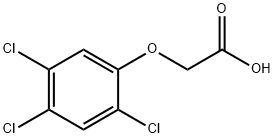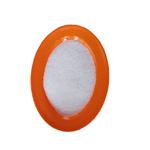Chemical Properties
2,4,5-T Acid is an odorless, colorless to tan crystalline solid.
Chemical Properties
white to light tan odourless solid
Physical properties
Colorless to pale brown, odorless crystals. Odor threshold from water is 2.92 mg/kg (quoted,
Keith and Walters, 1992). Metallic taste.
Uses
2,4,5-T was formerly used as a herbicide. Itis currently not used, following a ban by theEPA.
Uses
Plant hormone; defoliant; herbicide used to control undesirable brush and woody
plants.
Uses
It is suitable for plant cell culture tested. Post-emergence herbicide.
Definition
ChEBI: A chlorophenoxyacetic acid that is phenoxyacetic acid in which the ring hydrogens at postions 2, 4 and 5 are substituted by chlorines.
General Description
Light tan solid (melting point 153°C). Insoluble in water. Contact may irritate the skin.
Air & Water Reactions
Insoluble in water.
Reactivity Profile
2,4,5-Trichlorophenoxyacetic acid is a weak acid. Reacts with organic and inorganic bases to form water-soluble salts and with alcohols to form esters. Incompatible with strong oxidizing agents and strong bases. Can corrode metals, especially if moist. May harm painted surfaces .
Health Hazard
Overexposure to dust by inhalation or ingestion may cause fatigue, nausea, vomiting, lowered blood pressure, convulsions, coma. Dust may irritate eyes and skin.
Health Hazard
The toxicity of 2,4,5-T is very similar tothat of 2,4-D. The symptoms are irritationof skin, acne-like rash, somnolence, gastritis,fatty liver degeneration, and ataxia.
LD50 value, oral (rats): 300 mg/kg
Oral administration of this compound inhamsters and mice produced fetotoxicity,as well as developmental toxic effects onthe central nervous system, eyes, ear, andprostate.
Fire Hazard
Special Hazards of Combustion Products: Toxic hydrogen chloride and phosgene gases may be formed.
Potential Exposure
Those engaged in the manufacture, formulation, and application of this herbicide used to control woody and herbaceous weeds. The EPA has issued a rebuttable presumption against registration of 2,4,5-T for pesticide uses, however. The Viet Nam war era defoliant, Agent Orange, was a mixture of 2,4,5-T and 2,4-D.
Carcinogenicity
2,4,5-T was not mutagenic in bacterial
assays, and it did not induce aneuploidy or
somatic mutation in vitro. In vivo it did not
cause micronuclei in mice or dominant lethal
mutations in mice or rats.
Environmental Fate
Biological. 2,4,5-T degraded in anaerobic sludge by reductive dechlorination to 2,4,5-
trichlorophenol, 3,4-dichlorophenol and 4-chlorophenol (Mikesell and Boyd, 1985). An anaerobic methanogenic consortium, growing on 3-chlorobenzoate, metabolized 2,4,5-T to
(2,5-dichlorophenoxy)acetic acid at a rate of 1.02 × 10–7 M/hr. The half-life was reported to
be 2 days at 37°C (Su?ita et al., 1984). Under aerobic conditions, 2,4,5-T degraded to 2,4,5-
trichlorophenol and 3,5-dichlorocatechol which may further degrade to 4-chlorocatechol or
cis,cis-2,4-dichloromuconic acid, 2-chloro-4-carboxymethylenebut-2-enolide, chlorosuccinic
acid and succinic acid (Byast and Hance, 1975). The cometabolic oxidation of 2,4,5-T by
Brevibacterium sp. yielded a product tentatively identified as 3,5-dichlorocatechol (Horvath,
1970). The cometabolism of this compound by Achromobacter sp. gave 3,5-dichloro-2-
hydroxymuconic semialdehyde (Horvath, 1970a). Rosenberg and Alexander (1980) reported
that 2,4,5-trichlorophenol, the principal degradation product of 2,4,5-T by microbes, was
further metabolized to 3,5-dichlorocatechol, 4-chlorocatechol, succinate, cis,cis-2,4-dichlo-
romuconate, 2-chloro-4-(carboxymethylene)but-2-enolide and chlorosuccinate.
Soil. 2,4,5-Trichlorophenol and 2,4,5-trichloroanisole were the primary degradation
products formed when 2,4,5-T was incubated in soil at 25°C under aerobic conditions.
The half-life under these conditions was 14 days (McCall et al., 1981a). When
The half-lives of 2,4,5-T in soil incubated in the laboratory under aerobic conditions
ranged from 14 to 64 days with an average of 33 days (Altom and Stritzke, 1973; Foster
and McKercher, 1973; Yoshida and Castro, 1975). In field soils, the disappearance
Groundwater . According to the U.S. EPA (1986) 2,4,5-T has a high potential to leach
to groundwater .
Photolytic. When 2,4,5-T (10–4 M) in oxygenated water containing titanium dioxide
(2 g/L) suspension was irradiated by sunlight (λ ≥340 nm), 2,4,5-trichlorophenol, 2,4,5-
trichlorophenyl formate and nine chlorinated aromatic hydrocarbons formed a
Solubility in water
Soluble in ethanol (548.2 mg/L), ether (243.2 mg/L), heptane (400 mg/L), xylenes (6.8 g/L),
methanol (496 g/L), toluene (7.32 g/L) (quoted, Keith and Walters, 1992).
Shipping
UN2811 Toxic solids, organic, n.o.s., Hazard Class: 6.1; Labels: 6.1-Poisonous materials, Technical Name Required. UN3345 Phenoxyacetic acid derivative pesticide, solid, toxic, Hazard Class: 6.1; Labels: 6.1-Poisonous materials.
Purification Methods
Crystallise this herbicide from *benzene. [Beilstein 6 III 721.] (CANCER SUSPECT)
Incompatibilities
The aqueous solution is a weak acid. Incompatible with sulfuric acid, bases, ammonia, aliphatic amines; alkanolamines, isocyanates, alkylene oxides; epichlorohydrin; strong oxidizers, such as chlorine, bromine, fluorine, and strong bases.
Waste Disposal
Two disposal procedures have been discussed for 2,4,5-T: (1) Mix with excesssodium carbonate, add water and let stand for 24 hours before flushing down the drain with excess water; and (2) pour onto vermiculite and incinerate with wood, paper, and waste alcohol. In accordance with 40CFR165, follow recommendations for the disposal of pesticides and pesticide containers. Must be disposed properly by following package label directions or by contacting your local or federal environmental control agency, or by contacting your regional EPA office. Consult with environmental regulatory agencies for guidance on acceptable disposal practices. Generators of waste containing this contaminant (≥100 kg/mo) must conform with EPA regulations governing storage, transportation, treatment, and waste disposal.






